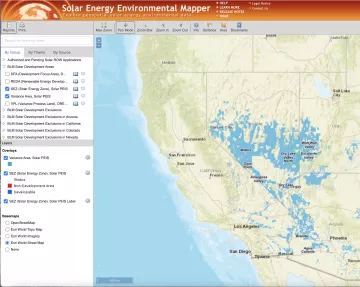By Lynn Boulton
The desert is being targeted for large-scale solar projects because it is flat, companies can lease public land cheaply, and they can install a project quickly. But, at what cost? It means the loss of endangered species habitat making extinction of some species probable, irreplaceable carbon sequestration, and relatively untouched nature. Half of Nevada has been made available for large-scale solar projects on top of many geothermal and proposed lithium projects under development. Now the northern half might be opened up to solar projects as well. Should there be a cap on how much of a state or type of ecosystem is sacrificed to meet our country’s goals for renewable energy? If so, should non-critical projects be stopped such as gold exploration and gold mining?
The BLM’s 2022 Solar PEIS project is revisiting the 2012 Solar PEIS project/Western Solar Plan in order to expand it to five more states and increase the amount of acreage renewable energy companies could choose from. In 2012, areas in Nevada that did not meet the exclusion criteria became variance areas where large-scale solar or wind could be developed. The northern part of the state was excluded based on two technical criteria: 1) solar insolation less than 6.5 kWh/m2/day, and 2) lands with a slope greater than five percent. These are criteria that the solar industry would like to change or eliminate with the 2022 Solar PEIS project. See the 2012 Solar map.
In 2012, five areas in Nevada were identified as solar energy zones (SEZs): Big Smokey Valley (west of Tonapah), Lida Valley-Gold Point, Dry Lake Valley north and Dry Lake (at the junction of Highway 15 and 93) and the Amargosa Valley. There is already one large-scale solar project in the Amargosa Valley in the Charleston View area with five more covering the adjacent lands in the pipeline—all six are in desert tortoise habitat. Here is a link to the BLM renewable energy projects in just the last four years.

The 2020 Energy Act sets a goal to issue permits for 25 gigawatts of power through renewable energy projects by 2025. Yes, we need to reduce our carbon emissions and convert to renewable energy now, but is this the only way to do it? The cost to our ecosystems is high. While it is easier, faster, and cheaper to exploit the desert, money shouldn’t be the only deciding factor. We need to put a price on nature to drive development towards already disturbed places, such as brown fields, parking lots, rooftops, or abandoned agricultural fields first.
Comments are due February 28, 2023.
Related article: BLM To Accelerate Solar Energy Development on Public Lands in the West